Body Piercing Types, Healing Times and Aftercare
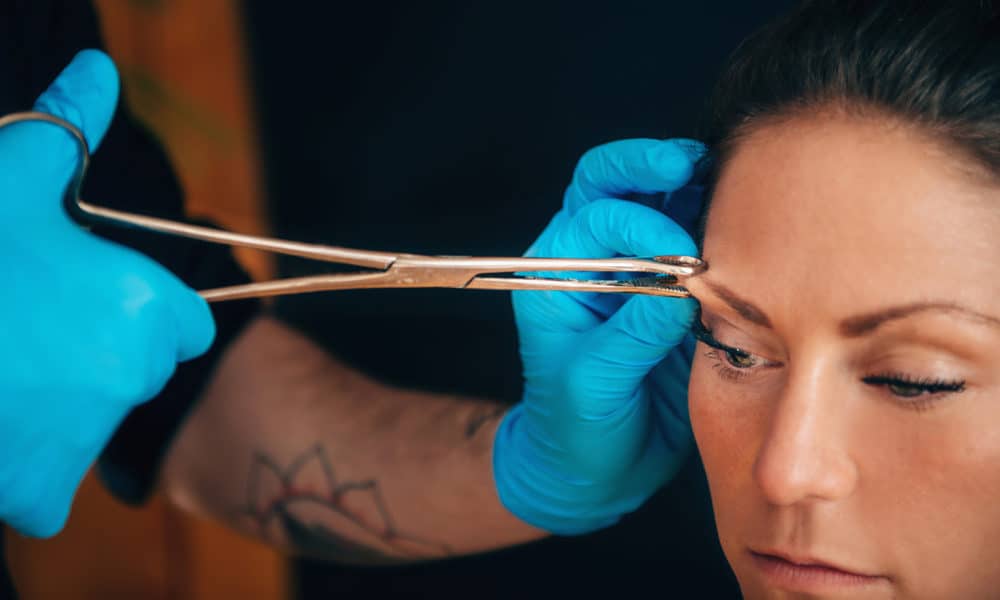
Body piercing is a form of body modification that is widely practiced for a plethora of reasons. Plainly put, body piercing involves puncturing a part of the body in order to adorn it with jewelry.
Body piercings appear in nearly every culture, all over the globe and throughout nearly everyone’s history and background. Some piercings have deep meanings ranging from spiritual and religious to personal significance, while others are social identifiers and others still are purely for ornament.
All in all, there is no doubt that body piercings exist for several reasons. The most common types of body piercings are ear and septum piercings. Earrings are one of the most popular jewelry options anywhere, even coming in a clip-on version. The option to fake a piercing is available for nearly every type of piercing there.
There are even Guinness world record holders for highest number of piercings. The record for ‘Most Pierced Woman’ was set by Elaine Davidson in March 2010 with 6,725 piercings, while the record for ‘Most Pierced Man’ was set by Rolf Buchholz from Dortmund, Germany with 453 total piercings.
Body piercing is considered to be a method of body modification and is meticulously regulated, much like thigh tattoos for women. Professional piercers take their craft seriously. The health, safety and comfort of their clients is very important to not only the piercers, but also the shops that they work at for reasons that are not limited to just their reputations.
The locations for many piercings can lead to a lot of discomfort for a long time if they are done incorrectly. Most piercers have quite a few piercings themselves so they are also a good resource for what to expect through their experience, not just what they have learned by doing piercings.
With so many different types of body piercings available, it is imperative to do your research, it is very important! Many piercers are well aware of the commonly confused piercings and will be happy to clarify or correct you to make certain you are aware of what you are asking for.
The term clitoral piercing is just an example for one of the very commonly confused piercings, but don’t worry we have a full breakdown of the types of body piercings you can get, where they go and even the average healing times for each.
Read on to learn everything about the origins and types of body piercings, healing times of each body piercing and more, or jump to learn about any other tips about body piercings below!
• Origins of Body Piercings
• Types of Body Piercings
• Ear Piercings
• Facial Piercings
• Nose Piercings
• Oral Piercings
• Lip Piercings
• Dermal Piercings
• Navel Piercings
• Genital Piercings
• Caring for Body Piercings
• Health Considerations
• Piercing Pain
• What Is Piercing Rejection and Migration?
• Treating Infected Piercings
• Faux Body Piercings
• Piercings At Home
• School Dress Codes and Piercings
Origins of Body Piercing
The oldest irrefutable proof of body piercing would be the 5300-year-old mummy ‘Otzi the Iceman’, who was found with a 11mm gauged ear piercing. While artwork and burial sites show jewelry-included designs to wear in piercings, the actual find of a pierced mummy is the best proof.
The origins of body piercing are easily and highly debated upon, though as it is a practice found in every culture worldwide, it is more of an argument of when rather than whom. Body piercings have ranged all over the body, the most common piercings having been found in ears, sections of the nose and the genitals.
Types of Body Piercings
Ear Piercings
As ear piercings are the most common piercing types, we will cover the wide variety of ear piercings first. The standard ear lobe piercing is also the most socially accepted piercing, though even with these piercings there are regulations in a lot of schools and even some businesses on the types of jewelry that can be worn.
There are at least 10 different type of ear piercings, though the final number is closer to 15. The variety is amazing and interesting, allowing a great number of ways to customize your own aesthetic. There are even earrings designed to connect several types of piercings to each other.
Ear piercings can be easy to clean and care for and can be done without an appointment and at piercing parlors and even jewelry stores, though basic earlobe piercing is the one provided at jewelry stores. The jewelry is picked out (be aware of allergies please!), the locations of the piercings cleaned and the piecing spots are marked with a surgical marker. The cleaning instructions and care instructions are usually given to you post piercing and are very easy to follow.
Here is a breakdown of the different types of ear piercings.
• Earlobe piercings are the most common, with some people getting these done as babies even in modern society. These sorts of piercings are nearly pain free, as they do not go through cartilage (the recommendation is that if a parent wants to pierce a baby’s ears, they should be done at 6 months and older and only the standard lobe piercing to ensure that the piercings stay centered on the earlobe as the baby grows).
There are several types of earlobe piercings. Most ear piercings take 3 to 9 weeks to heal.
- Standard lobe piercings are the typical centered ear lobe piercing. There is nearly no limit on the number of earrings designed for this type of piercing, from studs to gauges, to dangling earrings and hoops.

@caiqueleonpiercer
- Upper lobe piercings are typically the second ear piercing type people get and are slightly higher up.
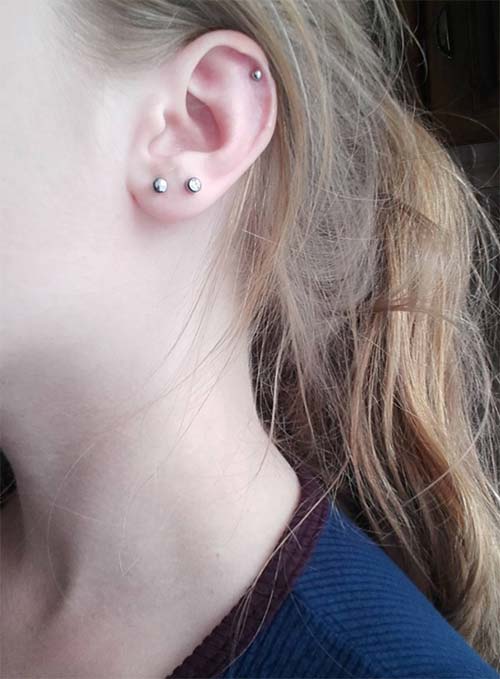
@ponpeoati
- Transverse lobe piercings have a great look and are done horizontally. The ends of the piercing, which is usually done with a bar earring for those with unattached earlobes or curved barbells for those with attached earlobes, let the ends of the earring show at both the left and right ends of the bottom of the earlobe rather than front and back.
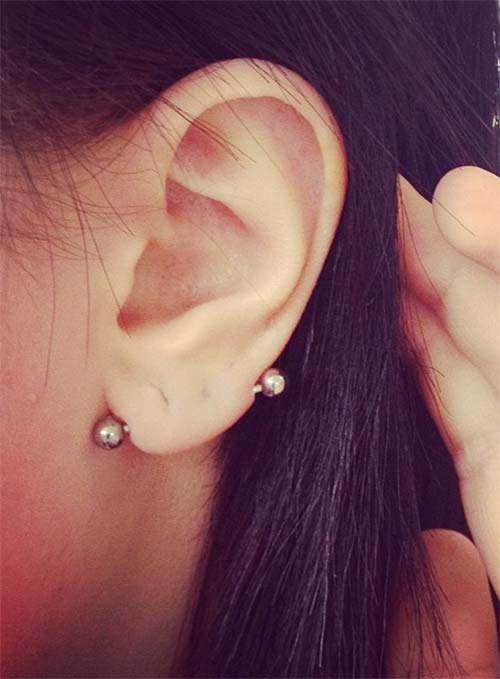
@bex_fozzy
• Cartilage or helix piercings are any piercing of the cartilage towards the top of your ear. Some of the coolest of these include several that go all the way up.

@caiqueleonpiercer
• A tragus piercing is a piercing of the lower section or flap of cartilage connecting your ear to your face. A tragus piercing takes 4 to 8 months to fully heal.

@caiqueleonpiercer
• An anti-tragus piercing is a piercing directly across from the tragus in the inner portion of cartilage. An anti tragus piercing usually takes 4 to 8 months to fully heal.

@allapiercer
• A daith piercing is done where the ear curves in right above where the tragus is and is also very close to the conch portion of the ear as well.

@verena_blume
• Conch piercings are in the lower cartilage inside the ear and have 2 different piercing options. Conch piercings take anywhere from 6 months to a full year to heal completely.

@caiqueleonpiercer
- Outer conch piercings are piercings in the outer shell of the ear.

@annieenasta
- Inner conch piercings are done in the center of the ear and are adjacent to the ear canal.

@muchoueno
• An industrial piercing is actually a combination of 2 piercings at adjacent points of the cartilage at the top of your ear. Initially a straight barbell is used to connect the two, but to promote healing initially, it is better to use 2 captive bead rings for the first year or 7 months at the minimum. Industrial piercings take 6 months to a year to heal.

@caiqueleonpiercer
• An orbital piercing is actually a connected set of 2 earlobe piercings along the outer edge of the ear lobe and usually takes 6 months to a year to heal.

@cassisoclassy
• Rook piercings involve the piercing of the cartilage above the tragus and between the upper half of the conch and the top curve of the ear and are also known as the antihelix. Rook piercings usually require 6 to 10 months of healing time.

@cassisoclassy
• A snug piercing (or anti-helix piercing) passes through the cartilage of the inner section of tissue known as the anti-helix. Snug piercings require 8 months to a year to fully heal.

@cassisoclassy
• A triple helix piercing is a trio of helix piercings in a row. A triple helix piercing is more often than not connected with a single stunning spiral shaped piece of jewelry or a triplicate of studs. These piercings usually take 6 to 10 months to heal completely.

@cassisoclassy
Facial Piercings
Facial piercings actually cover a wide range of piercings. Since eyebrows, noses and lips are all on the face, they can be rolled under the term ‘facial piercings’. The Guinness World Record for facial piercings is currently held by Axel Rosales of Maria, Argentina with 280 facial piercings alone. He has held this record since February of 2012.
Many of the piercings around the brow area are considered surface piercings. Surface piercings are much more prone to rejection than other types of piercings, and rely heavily on the technique and expertise of the piercing technician for proper installation. Surface piercings require enough skin and the right (in most cases, slightly heavier) gauge in order to reduce the chances that the jewelry could migrate out.
Lip and nose piercings are covered in greater depth below, but we cannot overlook other facial piercings. While nose piercings are the second most common piercing type worldwide, it is no surprise that they are nearly equally accepted.
• Eyebrow piercings can be placed either horizontally across the eyebrow or vertically through the eyebrow. Vertical eyebrow piercings are more common. Eyebrow piercings are considered a surface piercing and thus they need to be cared for accordingly, which means it will be more prone to rejection than some other piercings. These types of piercings usually heal within two to four months and are adorned with either a ring or a curved barbell.
- Horizontal eyebrow piercings are typically done above the upper ridge of the eyebrow.

@rendition
- Vertical eyebrow piercings are done through the ridge of the eyebrow and most commonly off center or very close to the tail end of the eyebrow.

@cassisoclassy
• Anti eyebrow piercings are done just at a slight angle and just below the outer corner of the eye on the upper cheekbone.
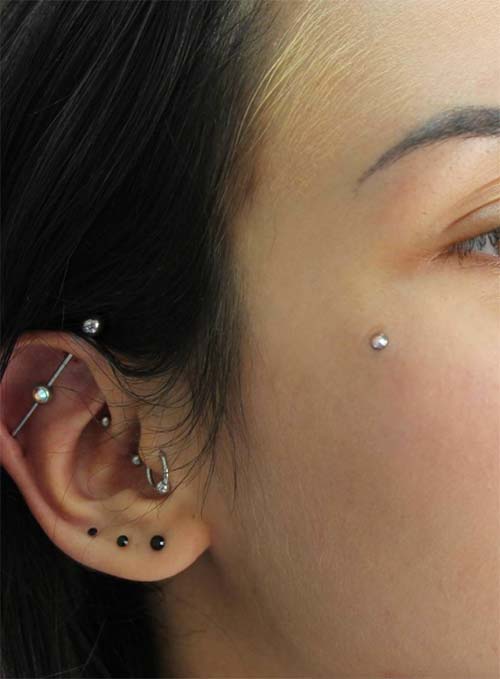
@caiqueleonpiercer
• Cheek piercings or dimple piercings are designed to create the illusion of dimples with a bit of sparkle. Dimple piercings are popular and can even be put in where your dimples naturally are (if you have them). The important thing to remember is that placement cannot nick the parotid duct. If the parotid duct is nicked, saliva can leak out onto the outside of the cheek, and to correct it would require cauterization.

@roniiixoxo
• Eyelid piercings are as stated, piercings through the eyelids, usually worn with rings, though some, depending on placement, have been worn with barbells. Though not as common, eyelid piercings do exist in a surprising number. Piercings through the eyelid can very easily cause damage and increased risk with wear and even at installation, not to mention the issues for anyone with eye allergies.

@caiqueleonpiercer
Nose Piercings
Nose piercings are second in popularity to earlobes around the world. Nose piercings are considered to be any piercing of the cartilage or skin of the nose, with the nostril piercing being the most common choice.
Nose piercings are often associated with Indian and African cultures though they are also seen in South America, Canada, Japan and generally anywhere African or Indian slaves were taken to. These nostril piercings remain steadily popular with no signs of diminishing or disappearing in importance or use.
• Nostril piercings have a lot of significance in several different Asian cultures and the Australian Aboriginal culture as well. Though there are African cultures that use nostril piercings, they are minimally recognized.
Nostril piercings are small piercings designed for jewelry and the nostril adornments can vary in size and structure as well as level of elaboration, with the stud and the loop being the most popular of options. In many cases a chain is attached from the nostril piercing to an ear piercing, connecting the two most popular piercing sites worldwide with a lot of flair.

@hailiebarber
• Bridge piercings are a surface piercing done through the skin found at the top of the nose, right between the eyes or slightly lower. Typically barbells ” straight or curved ” are worn in bridge piercings but in some cases, people enjoy a ring.

@pulseofawakeningg
• Septum piercings are carefully placed in the ‘sweet spot’ between the cartilage of the nose and the bottom of the nose. The number of nerves in the nose can make this a more painful piercing for some. Septum piercings have a lot of jewelry options available.

@okaspen
Oral Piercings
Oral piercings, most specifically tongue piercings are pretty quick healing piercings. Though swelling occurs, it usually disappears between 10 and 14 days and takes between 3 and 4 weeks to fully heal. Though the swelling and initial piercing is uncomfortable, most people who have a tongue piercing and other piercings have reported that the tongue piercing was the least painful of all.
For those worried it is similar to biting your tongue, it isn’t! A pierced tongue is a lot less painful than a bitten tongue. Once installed, taking care of these piercings is relatively easy, mostly requiring a rinse twice a day with an anti microbial mouthwash that is alcohol free, as well as rinsing with a saline solution twice a day that can be mixed at home with 8 oz of warm water with ¬¨¬®¬¨‚à´ tsp of non-iodized sea salt.
• Tongue piercings are typically done as a single piercing towards the center of the tongue, but many people have chosen to have multiples, sometimes combining types.
- Mid-line tongue piercings are the most often chosen tongue piercing type that is typically close to the center (horizontally) and about 1.9 cm in from the tip of the tongue.

@pircinginspiration
- Frenulum linguae piercings are considered to be a type of web piercing, done through the frenulum located beneath the tongue, usually accessorized by a ring.

@pircinginspiration
- Snake eyes piercings or tongue venom piercings typically use a curved barbell so that when the tongue is stuck out, it looks like the head of a snake with the eyes staring out.

@pircinginspiration
• Uvula piercings are uncommon but involve numbing the back of the throat and the uvula, and care must be taken once it is installed concerning rejection, discomfort and tearing at this point in the throat.

@faktorsieben
• Web piercings include the tongue frenulum piercings mentioned above, as well as smileys ” a piercing through the skin between the upper lip and the gums.
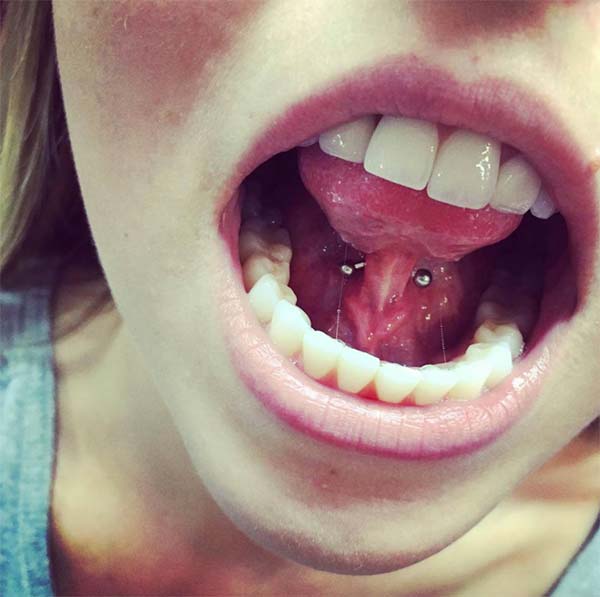
@stylztattoos
Lip Piercings
Lip piercings are usually a combination of two piercings for a cool look. Mostly they are combined with a version of septum piercing and two or more lip piercing styles. Some lip piercings are designed to mimic the beauty marks of icons like Marilyn Monroe and Madonna, while others that are wildly popular like snake and spider bites mimic nature. The variety of options makes this one more truly customizable way to engage in body modification.
Most lip piercings take between and on three months to heal depending on the site and are generally some of the least painful piercing options next to earlobe thanks to the lack of cartilage. Because these piercings are so close to your mouth if not on your lip or in your mouth they can be tricky to get used to.
Make certain to be careful while eating and enjoy cold foods, ice cream and cold milk to reduce swelling and avoid smoking and chewing tobacco as they can cause the healing process to take longer.
Lip piercings have as rich and varied a history and current use as earlobe piercings do. In several places around the world lip piercings can show the religious hierarchy off the wearer such as the Dogon tribe in Mali and the Nuba tribe in Ethiopia.
Because there are so many different options, they are visible and interesting and they are practically painless, lip piercings are very popular today for aesthetic only reasons.
• Angel bites piercings appear symmetrically on either side of the ridged or curved areas over your mouth called the philtrum. This is a modification of the Monroe and Madonna piercings and is also called anti bites, as it is the reverse of a set of snake bite piercings.

@pircinginspiration
• Snake bites piercings come in two different styles, typically rings or labret studs. Snake bite piercings are two evenly separated lower lip piercings that appear on the left and right sides of the lower lip.

@pircinginspiration
• Spider bites or viper bites piercings are a pair of closely placed, off-center piercings that sit on either the left or right of the bottom lip at a slight angle. Spider bites and viper bites piercings are recommended to be done one at a time, with the second being done after the first completely heals, as they are considered more painful than other lip piercings.

@pircinginspiration
• Canine bites are four total piercings that look to be a combination of angel bite piercings and snake bite piercings. Canine bites piercings are located symmetrically in a square around the mouth.
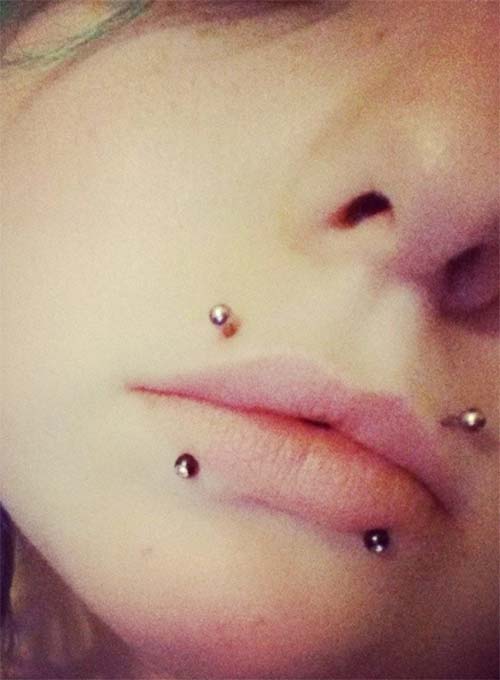
@pircinginspiration
• Cyber bites piercing is a combination of a labret piercing and a medusa piercing, both of which are pretty interesting on their own. The appearance of cyber bite piercings should be in line with each other, one in the middle of the upper lip, just above the cupid’s bow and the other just below the lower lip.

@ievalethal
• Shark bites piercings are two pair of spider or viper piercings, placed on both sides of the lower lip rather than one, for a total of four lower lip piercings.

@lauradiamond_92
• Dahlia piercings or Joker bites depending on your level of decorum are done at the corners of the mouth. The ‘Dahlia piercings’ name comes from the cuts at the corners of the mouth suffered by Elizabeth Short in 1947 when she was the victim in the infamously gruesome Black Dahlia Murder.
The alternate ‘Joker bites piercings’ name originated with the iconic villain known as the Joker from the Batman comics. His signature look features a painted clown-like mouth with exaggerated corners.

@pircinginspiration
• Dolphin bites piercings are 2 piercings that are centered, side-by-side on the lower lip with about the width of a finger’s space in between the two.

@sayuri_yusa
• A medusa piercing, which is also known as a philtrum piercing is centered above the cupid’s bow, between the middle of the upper lip and the bottom of the nose called the philtrum region. This piercing is typically done with a labret stud, with the ball sitting on the outside, visible above the cupid’s bow of the lip. There is another variation of this piercing called a jestrum piercing.
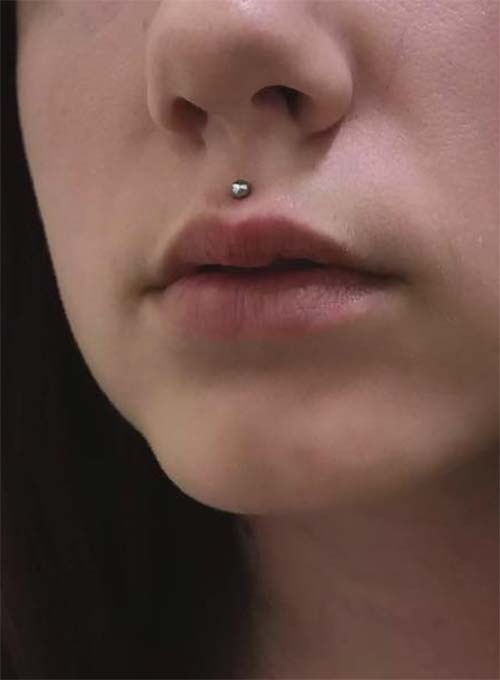
@annieenasta
• Jestrum piercings are similar to a medusa or philtrum piercing, as well as a vertical labret piercing and are also known as vertical medusa piercings. It is done on the top lip, pierced from the philtrum of the upper lip right under the nasal septum, but uses a curved barbell so that both ends of the piercing can be seen externally on the top and bottom of the upper lip.

@piercingstudio_wien
• Monroe, Madonna and Crawford piercings are placed in the same location as these stars’ signature ‘beauty mark’ upper lip moles.
- Monroe piercings are placed on the left hand side above the upper lip, the same place her birthmark is in, with a labret stud.

@legadotattoo
- Madonna and Crawford piercings are placed off center on the right.

@lau_incognita
• Vertical lip piercings refer to any single or multiple sets of lip piercings that go completely through the lip from the top to the bottom instead of from one side to the other.
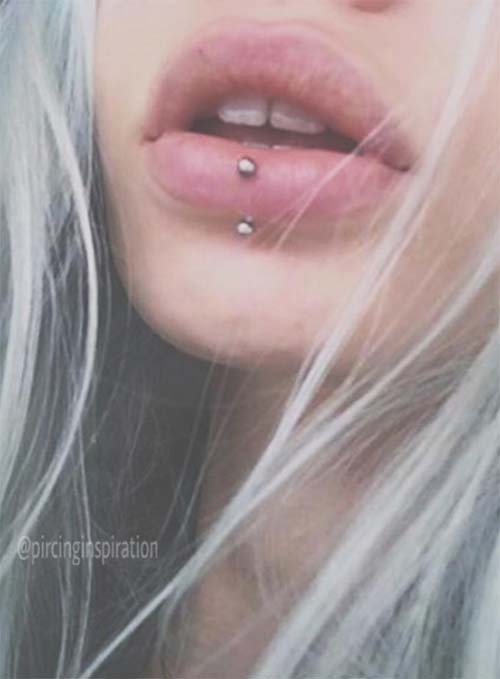
@pircinginspiration
• Horizontal lip piercings refer to piercings, where the lip is pierced from one side to the other (left to right) rather than top to bottom.

@piercingsbymaddyv
• Labret piercings are typically placed centered and right below the lower lip.

@itslikelymakeup
• Lowbret piercings are a type of labret piercings that are strategically placed as low as anatomically possible in the lower lip area.

@pircinginspiration
• A vertical labret piercing is done through the bottom lip and the piercing is done from top-center to bottom-center, and usually a curved barbell is worn. Both ends of the jewelry are visible with this piercing, which does not go through the interior of the mouth.
Dermal and Micro Dermal Piercings
Dermal and micro dermal piercings are also known as single point piercings. These types of piercings involve a piercing on a flat surface of the body and can be placed anywhere, leaving a lot of room for imagination. These types of piercings are considered to be a lighter version, called micro-dermal implants, than the more complicated transdermal implant surgeries that can create a similar look.
With these piercings, one end of the piercing is visible. The opportunity to create a pattern or design with piercings that appear to ‘float’ is one of the main reasons that dermal and micro dermal piercings are so popular right now.
These types of piercings usually take about an hour to install and can be done using either a needle or a ‘punch’ to install the micro-dermal piercing just beneath the skin, in the body tissue. The punch is quicker and less painful, so it is the method most often used.
Once the spot, where the install should be, has been identified, it is sterilized and marked with a surgical marker like all piercings are, and then either the needle is used to separate the skin or the dermal punch is used to create a pouch by removing a bit of tissue. The ancho is put in below the skin, and the visible jewelry is put in place with surgical forceps.
Since these piercings can be placed just about anywhere on the body with a flat skin surface, design options are endless and finding simple to intricate design options can be a lot of fun.
• Chest piercings are piercings put anywhere from the clavicle to the ribs. These can be done as micro dermal piercings or sometimes as a surface piercing with a bar that has 2 protruding ends.

@pircinginspiration
• Corset piercings are typically installed as dermal piercings that are done bilaterally at a minimum, but sometimes in a more elaborate design to allow a ribbon or two to be laced through them creating the appearance of the lacing on a corset. There are plenty of gorgeous variations on this and endless options for lace up designs.

@nahuel_beta_bodymod
• Face dermal piercings are often put in place on the face, where the skin is right over the bone like the area above the cheekbones.

@annieenasta
• Neck dermal piercings are placed on the nape of the neck and will look red and swollen initially, but afterwards they look stunning anywhere. Some put them on the side of the neck and in many cases in multiples.

@pircinginspiration
• Finger dermal and wrist piercings are popular, allowing the floating appearance of the jewel to accent a single or even multiple fingers. These dermal piercings are not often recommended even though they are popular because both fingers and wrists are in constant use and with the day or so of swelling involved with the piercing, this can make normal activities uncomfortable.

@pircinginspiration
• Back and hip dermal piercings are typically placed in the lower back but nearly any area in the back can receive these types of piercings. Once installed it is important to sleep on soft surfaces as harder services from firm mattresses to hard wood floors can cause discomfort, pain swelling and even rejection.

@annieenasta
• In case of dermal and micro dermal piercings with tattoos a base is implanted below the skin nearly anywhere on the body; the bottom of the decorative top should sit flush with the skin.

@pircinginspiration
Navel Piercings
Navel piercings (often mistakenly called belly button piercings) involve piercing the skin around the belly button. The most traditional navel piercing is done just above the belly button on the ring of skin surrounding it.
The actual belly button is not pierced, just at the top of the belly button cavity. Done this way the piercing usually features a dangling jewel or charm that floats over the belly button. There are navel piercings that are done in several places around the belly button cavity for more interesting designs.

@annieenasta
Genital Piercings for Women
Genital piercings for women provide more than aesthetic value, but pleasure as well. Nearly all types of female genital piercings provide a certain respectable amount of pleasure, though some are only applicable on certain anatomy. Not every woman can get every piercing.
Cleaning and caring for the piercing, however, is about consistency, and a bit more involved than other piercings considering the location. Tight jeans and leggings can make the healing process very uncomfortable and take longer if not careful. Take only showers for the first two weeks, just as a precaution and use saline solution when cleaning to maintain genital health.
The ideal situation regarding cleaning for both all genital piercings is to clean them in the shower. The healing time can range wildly and so paying attention to your steps to heal is imperative and the time will fly by.
When it comes to female nipple piercings, nipples are typically pierced horizontally, but they may also be pierced vertically or even at an angle. Straight barbells make the best starter jewelry for most people, although your piercer may recommend a curved barbell based on your anatomy.
It’s better to wait the 9-12 months until your nipples are fully healed to change to CBRs, which can put too much downward pressure on the healing piercing.
What To Expect At Your Piercing Consultation
Piercing consultations can happen prior to a piecing or you can schedule one post piercing if something seems off. This is especially important when it comes to certain piercings that require a specific type of anatomy. Piercing consultations are typically free or inexpensive as no work is actually done during the consultation.
General Dos and Don’ts When Caring for Body Piercings
Dos
• Clean your hands before touching your new piercing no matter where it is or what type of piercing it is.
• Use an anti-bacterial soap to clean the site of the piercing two times a day.
• Do you best to keep your piecing and site clean and dry and free of debris (hair, lint, etc.) while healing.
• Follow the instructions for dealing with your piercing jewelry, especially when manipulating the jewelry to clean the site.
Don’ts
• Fiddle with your piercing, especially with unwashed hands. Moving the piercing around while healing can cause a scar or malformation and increase the likelyhood of infection if you have not washed your hands
• Take anything that will thin your blood like aspirin, alcohol while you are healing, it can increase bleeding and uncomfortable swelling.
Health Considerations
In some cases, a piecing is just not an option. There are several reasons why a piercing cannot be performed by a professional piercer. In most cases, getting an opinion from another reputable piercer or even a physician who is well versed in piercings can be a tremendous help.
It is important to respect the decisions of the professionals, as they have not only their reputations on the line, but also the best intentions for your health and safety. Here are a few reasons why a professional piercer may request a second opinion or deny a piercing.
• The piercer does not have adequate training for the requested piercing. This can be especially true with very rare piercings that have a high risk factor. If the piercer is uncomfortable with the application or even the concept and believes that they could do more harm than good, he may choose not to perform the piercing.
• Auto-immune disorders, diabetes, hemophilia and certain other medical conditions can have an adverse effect on the piercing procedure or cause issues with the healing process.
• The site for the piercing is irregular naturally or surgically altered. This can make placement of the piercing more difficult or even painful when it should not be.
• There is a skin abnormality such as abrasions, scars, rashes, lesions lumps or bumps.
• Piercings that the professional piercer believes may not heal appropriately or at all.
• Pregnancy (current, impending or intent to become pregnant) can affect the options for piercing as navel, nipple and certain other piercings are not recommended for several reasons.
- Until it is healed, a piercing is an open wound.
- The body changes a lot during pregnancy and this can affect healing, placement and comfort of the piercing.
- Navel, nipple and many female genital piercings are all at sites that are specifically affected by pregnancy and the changing body of the mother.
• Heart conditions, though there are ways around this, such as a doctor’s consent and in some cases, a preventative antibiotic, but the suggestions really only apply to certain patients. Truthfully, if you have any sort of heart condition, it is better to consult your physician before taking steps to alter your body anyway. Examples of heart disease that causes concerns include:
- Prosthetic cardiac valve
- Previous endocarditis
- Cardiovascular disease
- Unrepaired cyanotic congenital heart disease
- Cardiac transplant with vascular disease
Piercing Pain
Pain is relative to the individual and thus is hard to gauge speculatively. That said, it is important to note that it is never silly to ask your piercer questions about the level of pain involved with a certain piercing. This is definitely a question they are prepared for, it will probably concern you more to ask than it will annoy the piercer to answer, so ask away!
When you are at your piercing consultation, you are there to get all the information you can about the piercing you are interested in. Your due diligence includes questions about piercing pain and any discomfort associated with healing.
The better prepared you are, the better off you will be. You can request a walk through of what to expect along the way and who to contact if you experience any level of discomfort you feel you were unprepared for.
On average the least painful piercings are surface piercings or areas that do not involve a lot of nerves or muscle. Earlobes, eyebrows and regular navel piercings are considered the least painful piercings you can get, as they are essentially surface piercings.
It is, however, worth considering that there are different types of pain as well and depending on which type of piercing you get, the type of pain you will feel could be different as well. With some piercings a quick pain that lasts less than 5 seconds is all you will feel, whereas with others with a more complex procedure, it is more a continued level of discomfort rather than actual, outright pain.
On a scale from least painful to the most painful (based on general reports) here are a few examples of piercings and their relative placement on a painful scale.
(Nearly) Pain Free Piercings
Piercings in this first category are pain free or very nearly pain free. There is no real extended discomfort, no real discomfort at all. Most people don’t feel any discomfort at all and this is because the area to be pierced is mostly a thin piece of skin making them surface piercings. Surface piercings are easier to take.
• Earlobes
• Eyebrows
• Regular Navel Piercings
Piercings Causing A Flash of Pain
Piercings in this second category can cause slight discomfort or just a flash of pain, but are overall not considered to be painful. If there is pain involved in the piercing process, it doesn’t last long.
Each of these is a bit different in the type of pain caused. For example, a tongue piercing is more uncomfortable than painful, while lip piercings can be outright painful to get initially. An important point to note is that oral piercings require a lot of care in order to heal properly.
• Inverse Navel Piercings
• Smileys
• Tongue Web Piercings
• Upper lip web Piercings
• Nostril Piercings
• Septum Piercings
• Tongue Piercings
• Ear Cartilage (these piercings are more uncomfortable during healing due to soreness initially.)
• Lip Piercings
Painful Piercings
Painful or uncomfortable piercings fall into the last category. These piercings almost all go through nerve dense or fleshy areas with muscle as well, but the pain is subjective.
• Nipple Piercings
• Corset Piercings (even though these are surface piercings, the number of them and the installation process can be the cause of the discomfort, as they are done in a higher number through patience and careful placement as they are installed and decorated. The placement can cause soreness, and discomfort even though these are temporary.)
• Certain Genital Piercings (not all are actually known to be painful, but may can be.)
What is Piercing Rejection and Migration?
Piercing rejection is when the body decides that your new piercing is a threat and begins pushing it out and healing shut to force out and keep out the object it deemed a threat.
Migration is the process that moves the piercing out of the body; it is the symptom of the rejection. Once a piercing has started to migrate, it is more and more likely that even if the piercing is saved, once healed, there will be some scarring. Any piercing can migrate, even healed several-year-old piercings can be rejected and migrate.
Piercing rejection and migration happens most often to surface piercings. The smaller the amount of skin or flesh to secure the piercing, the higher the risk of rejection and migration is. Your body has to accept the piercing, and as such some people are more prone to rejection and migration than others. Even the best placed piercing can be prone to rejection depending on the person.
Migration takes some time, weeks, sometimes moths, but the tell tale signs of migration are:
• Sensitivity or soreness at the site that does not lessen over time.
• Looser hanging jewelry, it may take time to be obvious but if the ring or bar looks looser, it is migrating.
• The hole of the piercing can appear to be larger as well.
• The skin the piercing travels through is thin enough to show the jewelry.
Preventing Piercing Rejection
Once migration starts, it is very difficult, nearly impossible to stop, so preventative measures are the best option. It is recommended that once a piercing is older than 24 hours you should stop using bandages. While it would appear to be counterintuitive to remove a barrier to germs and bacteria, the friction the bandage can cause can irritate the piercing site and increase the chance of rejection.
Do not remove body jewelry if the piercing site is infected. There are several reasons for this but the most important is that removing the jewelry can cause the exits of the piercing spot to close, locking the infection deeper into the skin. If you have decided to remove the body jewelry, do it after the infection has fully cleared.
Salt soaks are your friend during the healing stage! They promote cleanliness and healing at the site. If you suspect a light infection, use salt soaks, vinegar compresses, and visit to your professional piercer to know what to do. If the infection does not clear up with the vinegar compresses and salt soaks, if you develop fever or any actual discomfort, contacting your physician is a good and safe bet.
Consult your professional piercer. If you are dealing with piercing rejection, your professional piercer can replace the piercing with a smaller gauge to promote healing and lessen the likelihood of the rejection.
A visit to your doctor will likely result in antibiotics. It is better to be safe than sorry, but it is important to note that antibiotics can actually promote rejection, but nothing is worth a blood infection because a piercing was improperly treated.
Do not touch it! Another term for this is the LITHA Code, which stands for Leave It The Heck Alone. No matter how often you wash your hands, at some point your hands will be dirty and dealing with your piercings with dirty hands can cause rejection and infection. You don’t want either.
Noticing and Treating an Infected Piercing
Infections have telltale signs. Red inflamed skin around the piercing is expected around the piercing site initially only. Your professional piercer will give you the rundown on what to expect and what to look out for. No matter what, you should not remove the piercing if you have an infection. Serious concerns should be addressed by a physician, but removal of the jewelry is a definite no.
Infection usually occurs when the piercing is fresh and newer, as bacteria, germs and fungi can accumulate and cause an infection. In an effort to fight the infection you can use compresses in the initial stages of an infection.
Using saline rinses, which are sterile, helps keep the area clean, and keeping the area clean is imperative. Once the area has been cleaned, drying the area and keeping it dry is the next important step. A clean dry piercing site prevents the bacteria from growing and the infection from getting worse.
Infections are problematic on multiple levels, most notably that they can spread and cause damage even before they are life threatening. Following the care and instructions of the piercer will aid in keeping infection, rejection and migration at bay.
Treatment can be simple or extensive, but the idea is to avoid. An ounce of prevention is worth a pound of cure, but if you get an infection anyway, the earlier and more consistent your actions, the better your result will be. Infections increase the likelihood of rejection and migration, which no one wants to go through.
Faux Body Piercings
You can use faux body piercings to test out the look you are interested in or to tide you over until you can get your piercing done professionally. Certain piercings can be mimicked with pressure jewelry, magnetic jewelry and even stick-on jewelry.
If you are unsure if you can pull off a look ” try the faux version. If you are saving up money for the piercing, try the faux version if you just can’t wait. If you are too scared or are prone to rejection or even if your anatomy would not properly allow for a certain piercing, a faux piercing can almost always substitute.
Depending on your dedication to wearing a faux piercing, shop for quality that will last and materials that will not cause discomfort, discoloration or issue. Clip-on earrings have been around for a very long time and now they are available in place of other piercings.
The magnetic versions are reliable as long as you get the quality ones with a strong enough magnet in them. Pressure jewelry works by utilizing a certain level of pressure to hold the piercing in place.
There are faux body piercing options for tongue, nose, belly, lip, labret, Monroe and ear piercings. They come in spring hoops, clips, magnetic studs, stick-on, faux plugs and tapers as well. The options for what you want are available, just shop with quality in mind.
Purchase higher quality metals from places with good, reliable reviews. You can get the look you want with no needles, no healing times and no discomfort. If you are using it in the meantime, it is an easy installation and you can get used to living with the piercing and testing out your new looks without worrying about redness and swelling or tenderness until you are ready.
You can also look for faux body piercing jewelry that uses your current piercings as a base and extends to include nearby areas. There are several earrings designed like this. Fake plugs and curved earrings that create the look of cartilage piercings that travel up from an earlobe piercing are great options that can be found nearly anywhere.
An additional benefit to the faux piercings is the lack of lingering damage as well. Faux earrings that look heavy usually are not, meaning that there is no dragging of your piercing site, no stretching of the hole for the piercing either.
Faux piercings are a great option for a number of reasons and should not be overlooked. Considering the options, faux piercings make a great way to really find out what you want without breaking the bank or creating modification you were not certain about. Shop around and find what makes you happy.
Can I Do Body Piercings at Home?
Body piercings at home are not recommended, even for the simpler surface piercings. Rejection, migration, infection, improper placement and injury are not as easily avoided without a trained professional, so if you are not one, doing a piercing at home is a bad idea.
Even if you are a professional piercer, doing the piercing yourself is not a great idea. The piercing is more likely to be crooked at the very least if not uncomfortable.
School Dress Codes and Piercings
Many schools have a dress code that only allows for the wearing of a single pair of earrings at a time, with the sizes being strictly enforced in some cases to studs, not gauges and hoops that are less that a dime’s dimensions in size. In a lot of cases even the materials are limited to certain metals in order to bar distractions caused by colors and designs.
Since many nose piercings have a religious or cultural background to them, a small nostril piercing is usually allowed as long as it is a small and inconspicuous stud. Rules are stricter in many private schools and primary schools, where nothing more than a small pair of earrings is expected.
The reasons behind the stipulations are varied and can include:
• Safety: This is true for younger kids, as they are very active and earrings that are easily caught can be torn, traumatizing the children. This is also applicable to sports teams, where most jewelry is either removed or very small and rounded.
• Uniform Appearance: For teams (cheerleaders, choirs and step teams, for example) similar appearance is important ” for example, similar hairstyles, identical uniforms and similar makeup and jewelry or the team can be docked points in competition.
• Prejudice: Body modification of any kind is frowned upon in some circles. As individuality is only permitted in small amounts by some, they have a tendency to attempt to oppress it out of others. This sort of behavior actually leads to an increase in people rebelling by wearing them more often or seeking them out.
These same dress codes and prejudices are mirrored in the adult working community. This is changing, a minute amount at a time, but it is changing. Individual expression that causes no harm to others is becoming easier to accept and appreciate.
YOU MIGHT ALSO LIKE:
Cute Small Tattoo Ideas For Women Who Want to Enrich Their Look
Share via:


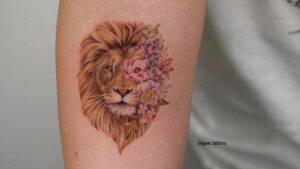



Leave a Comment